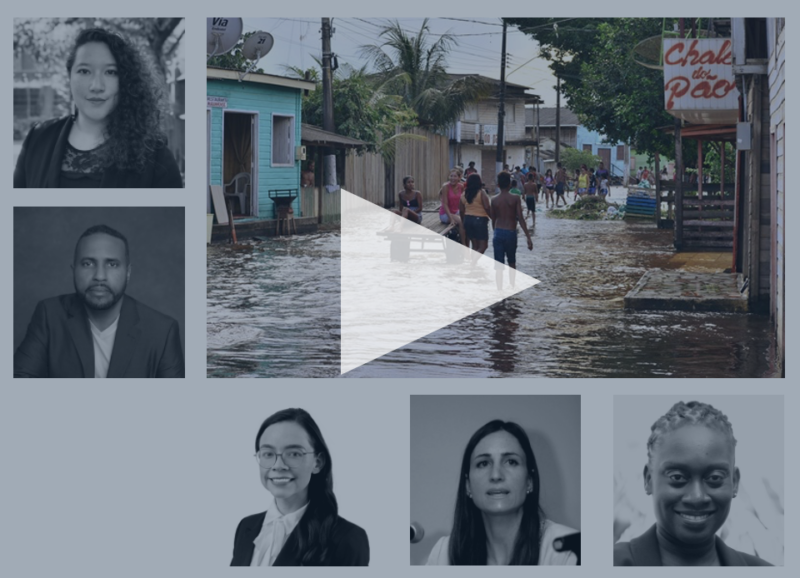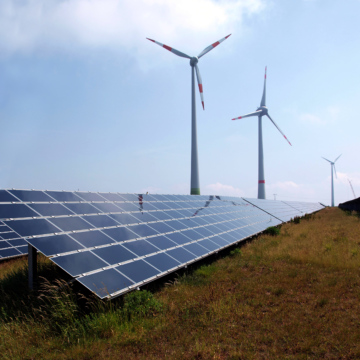Will the New US Aid Plan for Central America Be Successful?
Will Central American governments spend the money effectively? Do the countries in the isthmus have a good plan to fight the drug cartels?
Mitigating and adapting to climate change in Latin America and the Caribbean will require unprecedented financing. To explore the innovative tools key to materializing these financial flows, Inter-American Dialogue hosted the online event “Unlocking Climate Finance in Latin America and the Caribbean” on May 8, 2023. Daniela Stevens, program director and moderator of the event, gave opening remarks and then proceeded to introduce the panel of experts.
To set up regional context, Sandra Guzmán Luna, founder of the Climate Finance Group for Latin America and the Caribbean, outlined several key climate financing trends. Latin America and the Caribbean receives less funding for climate assistance than both Africa and the Asia-Pacific region, and, of the financing they do receive, 60 to 70 percent are in the forms of loans. In a region already faced with widespread indebtedness, adding to the debt burden presents challenges. At the same time, access to loans is very unequal across countries. Most loans go to Brazil, Mexico, and Colombia, with other countries receiving comparatively less. Of these investments, around 80 percent of financing goes towards mitigation, and less than 20 percent is directed towards adaptation. Unfortunately, for the top carbon emitting countries in Latin America, financing for and revenues from carbon-intensive activities vastly overshadow those of sustainable activities.
Lisa Viscidi, energy and climate specialist at Deloitte Consulting, and non-resident senior fellow at the Inter-American Dialogue, broke down the primary types of climate finance flows and explained why adaptation projects receive less financing. Climate projects either finance mitigation, typically through physical infrastructure, or adaptation, through nature-based solutions. Given the long history of foreign investment in infrastructure, the risks for mitigation projects are well known. For example, high interest rates can cause the cost of capital to increase, and local currency devaluation amidst high foreign exchange rates could reduce revenue for international companies. These types of risks can be circumvented or mitigated through tools used in the terms and conditions of contracts. In comparison, despite the growing need for adaptation projects, there is less knowledge about what the risks are and how to avoid them. Moreover, adaptation is less commercially feasible as most projects tend to be small scale with unviable or unclear revenue streams. This makes it less attractive to traditional investors. Guzmán Luna agreed, explaining that adaptation often requires smaller-scale, decentralized investments, not a multi-million-dollar project deals. Development banks have a role to play in decentralizing financing and building capacity at the local level to absorb these resources.
Taking a broader view, Guzmán Luna also pointed out that mitigation projects often involve technology substitution; in comparison, nature-based adaptation is a process requiring long-term projections. Viscidi pointed out that for non-nature-based adaptation tools, such as deploying a battery to prevent blackouts during extreme weather, the financial benefits can and should be calculated. However, for most nature-based adaptation processes, their long timelines are unattractive to many multilateral funds and bilateral cooperation initiatives that hope to see measurable changes in one to two years. Guzmán Luna pointed out how this myopic view will result in lower economic outcomes down the line as companies and countries find themselves vulnerable to climate impacts. Justin Ram, CEO of Justin Ram Advisory Associates and former director of the Economics Department at the Caribbean Development Bank, agreed and explained that financing for adaptation is complicated primarily because the benefits associated with it will occur well into the future. As Ram pointed out, our tendency to discount future benefits at too high of a rate has led to insufficient investments in the future livability of the planet.
For this reason, Ram suggested that the type of tools and investor practices used to finance resiliency and climate adaptation must change to adapt to these unique circumstances. Given the greater risks for adaptation financing, debt financing cannot be the only tool used. Instead, Ram recommends a blend of equity and debt financing as well as transforming credit agency rating processes to account for resilience risks. Viscidi mentioned other innovative adaptation financing tools that are already taking off such as green bonds, carbon credits, and debt-for-nature swaps. She also mentioned a lesser-known tool called special assessment districts, which finances an adaptation project through a public-private partnership using tax revenues from the specific geography where project beneficiaries are located. Lastly, Viscidi recommended the aggregation of multiple, decentralized adaptation projects into one investment package to make it more attractive for investors.
While many tools are proliferating to attract different financing sources, it is crucial to set rigorous standards for monitoring, reporting, and verification of projects so that the party putting up the capital can ensure it is used correctly. Creating green taxonomies, the legal categorization of which types of projects are considered “climate friendly,” is a first step for governments in guiding private sector investments. As Guzmán Luna pointed out, taxonomies should exclude gas projects in order to support clean infrastructure of the future. Setting up government-required monitoring, reporting, and verification systems through credible sources is also imperative.
To better take advantage of new tools, and ultimately reach the colossal amount of financing needed, indebted governments have called on development banks to increase adaptation funding. Guzmán Luna brought up the Bridgetown Initiative, which aims to restructure international financing and debt to meet developing countries’ realities. Guzmán Luna pointed out that international financial institutions were born out of a post-world-war context, and now they must radically change to adapt to a completely different set of challenges. Going deeper, Ram discussed how credit rating agencies should change their metrics for assessing development banks. Many development banks are risk-averse; however, the type of development assistance needed naturally requires risk-taking. Thus, banks fall short in the aid they provide for the planet’s greatest development needs.
Viscidi explained that commercial banks also have a role to play in financing climate action. First, banks can become aware of their contribution to climate change by developing their own carbon accounting and carbon risk methodologies. For instance, to advance its climate responsibility, Ban Colombia created a policy to quantify its scope one, two, and three greenhouse gas emissions. Second, banks can capitalize on the green finance opportunities; for example, Ban Colombia issued a green bond purchased by the International Finance Corporation to finance clean energy and energy efficiency projects in the country. However, as Viscidi explained, other small and midsized banks typically do not have the technical capacity to incorporate these processes. Sharing experiences among industry groups, and providing technical support on international disclosure frameworks, can help banks to continue to play a larger role in climate finance going forward, Viscidi recommended.
To illustrate the importance of working with commercial banks, Jacqueline Musiitwa, senior climate finance advisor at US Agency for International Development (USAID), gave the example of USAID’s Sustainable Banking Alliance which increases the capacity of banks in Colombia to access climate finance. In partnership with banking associations and international climate finance organizations, the program builds capacity in climate risk reporting, carbon accounting across financial portfolios, and climate finance lending. The next step is to build capacity of civil society to request and use domestic climate financing. Lastly, amidst bank collapses, Ram pointed to the opportunity to limit excess liquidity in commercial banks and require remaining liquidity be invested in development funds. Other panelists also discussed investing pensions into green development funds. These actions would reorient commercial banking architecture towards development needs.
All panelists agreed on the importance of local involvement in adaptation projects. Although time-consuming, consulting with all stakeholders related to a project can ensure the longevity of the project and its success in meeting local needs. Viscidi recommended that projects tackle both mitigation, adaptation, and local development needs in order to satisfy a broader array of stakeholders. However, she also acknowledged that achieving this requires understanding local dynamics and designing projects unique to each context. Projects also need to build capacity with stakeholders to ensure that once the project ends, a local green financing ecosystem can still flourish.
Recognizing the critical role of local actors, USAID recently created a robust localization strategy, as delineated by Musiitwa. The goal of the strategy is to ensure that communities play an integral role in the project design process and become equipped to receive and deploy funds in the future. Specifically, USAID has set the goal that by 2025, 25 percent of funding will go directly to local organizations, and by 2030, that number will be raised to 50 percent. To help climate finance reach local communities in the meantime, USAID created the Climate Finance Accelerator, which is a US$250 million initiative designed to mobilize US$2.5 billion in public and private climate investments by 2030. This global mechanism invests in projects that otherwise wouldn’t have been invested in through both grants and bilateral partnerships with the private sector. One new project example is the Blue Green Investment Corporation, which is a co-investment project between the Green Climate Fund, USAID, and the government of Barbados. The project seeks to fund mitigation and adaptation projects throughout the Caribbean, especially through capacity-building to enable small and medium enterprises to enter the green economy.
Overall, panelists confirmed that outdated risks analysis practices prevent finance from flowing to where it is most needed, and development financing needs systemic reform to enable it to respond to society’s most pressing needs. While climate financing will continue to come from “top-down” sources, involving local stakeholders in the planning process key to ensuring project buy-in, sustainability, and efficacy.
Will Central American governments spend the money effectively? Do the countries in the isthmus have a good plan to fight the drug cartels?
Though the COP21 negotiations promise to be complex, they also present an opportunity for the region to address existing vulnerabilities.
Development banks should play a great role in ensuring sustainable infrastructure development in Latin America in the coming years.


